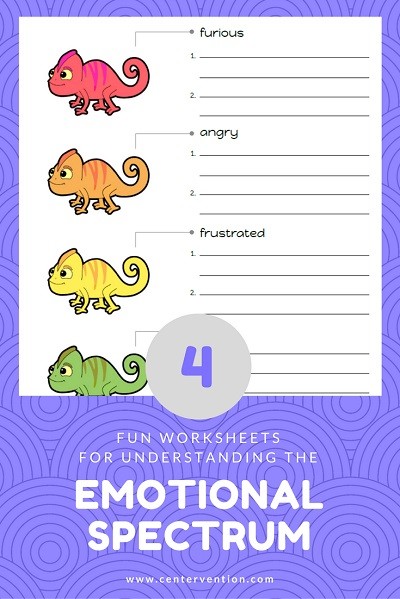It’s important that students learn to identify the degree of emotion they are feeling and use words that are more descriptive than mad, sad, happy, etc. Mad, sad, happy and scared are primary emotion words and are the basis for identifying feelings, whereas feelings like devastated, furious, elated, etc. convey much more precisely what someone is experiencing.
When kids can describe their feelings with specificity, it is easier for them to understand their own feelings and have others understand their feelings as well. This understanding will also help them with empathy, being able to recognize how others might feel in specific situations.
In a prior lesson, we focused narrowly on the range of words that people use to convey feelings on anger. But, in the emotion words worksheets below, students will evaluate a broader range of emotions and identify situations that make them feel that way.
Note: You may want to use this list of emotions as a reference.

Emotion Words Worksheet One
Start the discussion by asking students the following questions:
- What’s the difference between being annoyed and being furious?
- Are there any other emotions that are similar to each other like that, but some might be smaller feelings and some might be bigger feelings?
Group Instructions:
Cut out the sets of emotion words, mix them up, and arrange them face up on a table or on the floor.
- Tell the group they will be working together to sort words in this activity
- Students should first work to make stacks of the words that go together under the same emotion.
- Next, students should put each stack in order from the strongest to the least strong emotion.
Individual Instructions:
If you are working with individual students or in a remote learning enviroment, you can share the worksheet with each student and ask them to rank each emotion word from strongest to least strong by writing 1, 2, 3, or 4 beside each word.
Discussion:
Once students have correctly sorted and ordered the emotion words, bring students together to discuss:
- Were there any words that you weren’t sure where they fit?
- Was it hard to put the emotions in order from biggest to smallest?
- Do you think all emotions have different degrees like this? Can you name any others?
- Why is it important to know the degrees of different emotions?
Emotion Words Worksheet Two
In this activity, your students will read each emotion word, reflect on a situation that caused that emotion, and write about it in the space to the right of each word.
After students complete the worksheet, point out that there are small emotions and big emotions, and different situations will cause us to feel these different degrees of emotions. Being specific about how we feel and using the right terms helps others better understand how we’re feeling and how to help us.
Additional Resources
Books
- The Way I Feel by Janan Cain
- Me and My Feelings by Vanessa Green Allen
- The Lonely Little Emoji by Harry Harmon
- Daniel’s Good Day by Micha Archer